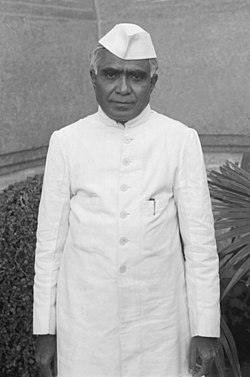Burgula Ramakrishna Rao
This article has multiple issues. Please help improve it or discuss these issues on the talk page. (Learn how and when to remove these template messages)
|
Dr. Burgula Ramakrishna Rao | |
|---|---|
 Rao in 1952 | |
| 12th Governor of Uttar Pradesh | |
| In office 1 July 1960 – 15 April 1962 | |
| Chief Minister | Sampurnanand Chandra Bhanu Gupta |
| Preceded by | V. V. Giri |
| Succeeded by | Bishwanath Das |
| 1st Governor of Kerala | |
| In office 22 November 1956 – 1 July 1960 | |
| Chief Minister | E. M. S. Namboodiripad Pattom Thanu Pillai |
| Preceded by | Office Established |
| Succeeded by | V. V. Giri |
| 2nd Chief Minister of Hyderabad State | |
| In office 6 March 1952 – 31 October 1956 | |
| Governor | Mir Osman Ali Khan |
| Preceded by | M. K. Vellodi |
| Succeeded by | Office Abolished (Neelam Sanjiva Reddy as Chief Minister of Andhra Pradesh) |
| Personal details | |
| Born | Pullamraju Ramakrishnarao 13 March 1899 Padakallu Village, Kalwakurthy, Hyderabad State |
| Died | 15 September 1967 (aged 68) |
| Nationality | Indian |
Dr. Burgula Ramakrishna Rao (13 March 1899 – 15 September 1967) was the first elected Chief Minister of the erstwhile Hyderabad State. Prior to the independence of India and the political integration of the princely states into the Union, he was among the Telugu-speaking leaders to resist the Nizam in the princely state of Hyderabad.[1][unreliable source?]
Early life[edit | edit source]
Burgula Ramakrishna Rao was born in a Telugu Brahmin family in Padakallu village, Kalwakurthy taluk in Mahbubnagar district. Though his surname was Pullamraju, he would be more popularly known among the Telugu people by his village name, Burgula. He was educated at the Dharmavanth and Excelsior High School in Hyderabad, where he would receive a B.A. (Honours) degree from Fergusson College, Pune and a law degree from Bombay University in 1923.[citation needed]
Career[edit | edit source]
This section does not cite any sources. (February 2021) |
He received famous “Allies” scholarship and graduated in law in Mumbai and took up the legal profession in Hyderabad but continued for a few days only. He was imprisoned twice for participating in public movements. He gave up the law portfolio given by Mirza Ismail, the Dewan (Prime Minister) of Hyderabad State.[citation needed]
He was one of the founding members of the Hyderabad State Congress. He presided over the second Andhra Mahasabha conference at Devarkonda in 1932 and gave direction for Telangana society. He also worked as a secretary for Hyderabad Swadesi League and Nizam Subjects League. He was also involved in promoting the library movement in the State.[citation needed]
He worked as a Revenue Minister in the cabinet of Vellodi government (1950) which was formed after police action. He got victory from Shadnagar constituency in the first sovereign elections held in 1952, and became the first Chief Minister of Hyderabad. After the termination of Nizam rule, in a short period he formed a stable democratic system with his administrative skill. He eradicated the system of jagirdar and mukthedar in Telangana and introduced the law of tenancy and became the first Indian land reformer.[citation needed]
The services of Burgula spread not only in Telangana but also to neighbouring areas. After the formation of Andhra Pradesh in 1956, as a Governor of Kerala state, he showed his statesmanship and got acclaim from many top politicians. When he was Governor of Uttar Pradesh, he was elected as a member of Rajya Sabha in 1962 to 1966.
From November 1956 to July 1960, Dr. Ramakrishna Rao was the Governor of Kerala, and in July 1959 he dismissed the first elected Communist govt in India, the first time article 356 was used in India. Later he was Governor of Uttar Pradesh till April 1962. He was later elected to the Rajya Sabha. In which he served from 1962 to 1966. He died on 14 September 1967.[citation needed]
Personal life[edit | edit source]
Burgula Ramakrishna Rao was married firstly to Smt. Radha Bai and later to Mrs. Ananthalakshmi Devi and is survived by his son, Burgula Lakshmi Narayana Rao.[2] His parents were Sri Narsing Rao and Mrs. Ranganayakamma and his younger brother was the late Sri Venkateshwara Rao.
His eldest son late Shri Burgula Ranganatha Rao died in 2008 and Shri Lakshmi Narayana Rao is his only surviving child. He is also survived by his grandsons, Burgula LakshmiKanth, Burgula Sai Ramakrishna, and Burgula Pavan Kumar. Shri late Ranganatha Rao has four surviving daughters Mrs. Jayadevi, Mrs. Vasumathi, Mrs. Radha and Mrs. Prabhavathi. Dr Illindala Prabhakara Rao, Padmaja, Sharada are his grand children born to his eldest daughter late Mrs. Syamala Devi. He is survived by Mrs. Aruna, daughter of the eldest daughter Indira of Mrs. Ananthalakshmi Devi.[citation needed]
Commemorations[edit | edit source]
A gold medal was instituted for the meritorious students in Humanities (Philosophy) at Sri Sathya Sai Institute of Higher Learning by Sathya Sai Baba himself.[citation needed]
The leadership of Shri T. Anjayya saw the establishment of the Dr. BRKR Government Ayurvedic College in the S.R. Nagar suburb of Hyderabad. It an institution in the state of Telangana for the academic discipline of Ayurveda.[citation needed]
See also[edit | edit source]
- 1951–52 elections in India
- List of Chief Ministers of Andhra Pradesh
- List of chief ministers of Telangana
References[edit | edit source]
- ↑ "The Hindu : Briefly". Hinduonnet.com. 14 March 2004. Archived from the original on 14 February 2008. Retrieved 3 December 2010.
{{cite web}}: CS1 maint: unfit URL (link) - ↑ "Andhras taking my father's name for selfish reas". The New Indian Express. 19 December 2009. Retrieved 3 December 2010.
External links[edit | edit source]
- http://www.teluguwebsite.com/Telugu_Pramukhaandhrulu.html
- Indian states after 1947 A-L
- http://burgulafamily.webs.com/
- http://www.thehansindia.com/posts/index/Hans/2013-09-19/The-role-of-Burgula-in-Telangana/72201
- https://web.archive.org/web/20161220121445/http://historyawareness.blogspot.in/2015/04/the-role-of-andhra-mahasabha-in.html
